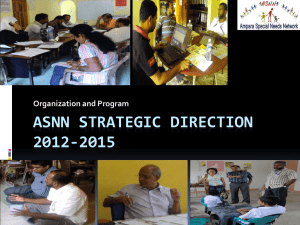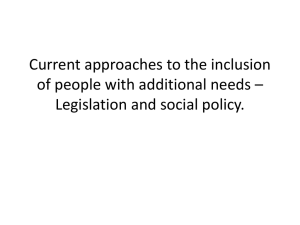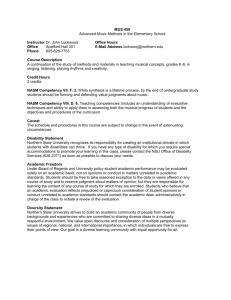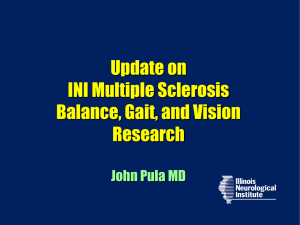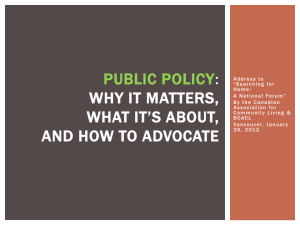National Disability Advocacy Framework
advertisement
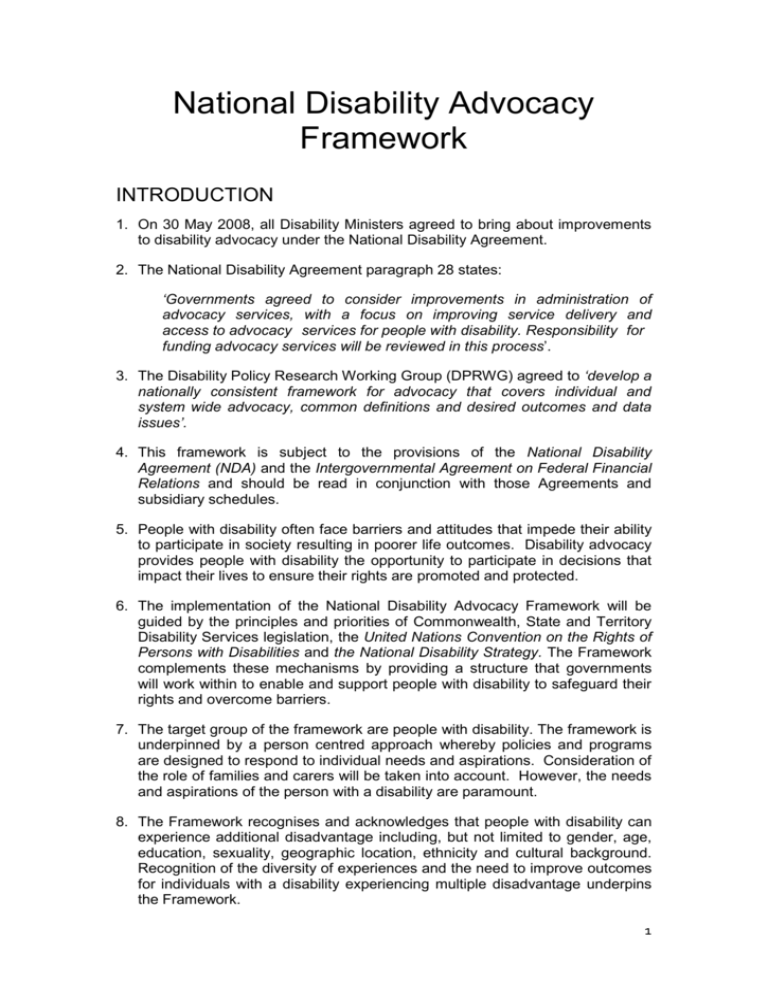
National Disability Advocacy Framework INTRODUCTION 1. On 30 May 2008, all Disability Ministers agreed to bring about improvements to disability advocacy under the National Disability Agreement. 2. The National Disability Agreement paragraph 28 states: ‘Governments agreed to consider improvements in administration of advocacy services, with a focus on improving service delivery and access to advocacy services for people with disability. Responsibility for funding advocacy services will be reviewed in this process’. 3. The Disability Policy Research Working Group (DPRWG) agreed to ‘develop a nationally consistent framework for advocacy that covers individual and system wide advocacy, common definitions and desired outcomes and data issues’. 4. This framework is subject to the provisions of the National Disability Agreement (NDA) and the Intergovernmental Agreement on Federal Financial Relations and should be read in conjunction with those Agreements and subsidiary schedules. 5. People with disability often face barriers and attitudes that impede their ability to participate in society resulting in poorer life outcomes. Disability advocacy provides people with disability the opportunity to participate in decisions that impact their lives to ensure their rights are promoted and protected. 6. The implementation of the National Disability Advocacy Framework will be guided by the principles and priorities of Commonwealth, State and Territory Disability Services legislation, the United Nations Convention on the Rights of Persons with Disabilities and the National Disability Strategy. The Framework complements these mechanisms by providing a structure that governments will work within to enable and support people with disability to safeguard their rights and overcome barriers. 7. The target group of the framework are people with disability. The framework is underpinned by a person centred approach whereby policies and programs are designed to respond to individual needs and aspirations. Consideration of the role of families and carers will be taken into account. However, the needs and aspirations of the person with a disability are paramount. 8. The Framework recognises and acknowledges that people with disability can experience additional disadvantage including, but not limited to gender, age, education, sexuality, geographic location, ethnicity and cultural background. Recognition of the diversity of experiences and the need to improve outcomes for individuals with a disability experiencing multiple disadvantage underpins the Framework. 1 DEFINITIONS 9. The following definitions provide a description of the advocacy services provided under this Framework: (a) Disability advocacy enables people with disability to participate in the decision making processes that safeguard and advance their human rights. (b) Individual advocacy supports people with disability to exercise their rights, through either one-to-one support, or by supporting people to advocate for themselves individually, through a third party or on a group basis. (c) Systemic advocacy seeks to introduce and influence longer term changes to ensure the rights of people with disability are attained and upheld to positively affect the quality of their lives. PRINCIPLES 10. The parties to this Framework accept and adopt the following National Disability Advocacy Principles as guiding the provision of advocacy for people with disability in Australia: (a) Disability advocacy operates under relevant Commonwealth, State and Territory legislation and the principles of the United Nations Convention on the Rights of Persons with Disabilities and other relevant United Nations Rights Treaties, to protect and promote the legal and human rights of people with disability; (b) Disability advocacy promotes the interests and wellbeing of people with disability and promotes their full and valued inclusion as contributing and participating members of the community; (c) Disability advocacy seeks to influence positive systemic changes in legislation, policy and service practice and works towards promoting inclusive communities and awareness of disability issues; (d) Disability advocacy promotes leadership and capacity building by people with disability; (e) Disability advocacy ensures that views represented meet the individual preferences, goals and needs of people with disability; (f) Disability advocacy strengthens the capacity of people with disability to speak for themselves by actively supporting and encouraging selfadvocacy; (g) Disability advocacy recognises and respects the diversity of people with disability; (h) Disability advocacy ensures that the rights of people with disability to privacy, dignity and confidentiality are recognised and upheld; 2 (i) Disability advocacy will foster effective strategic alliances to develop capacity to identify and respond to the needs of people with disability. OBJECTIVES 11. Through this Framework, the Parties commit to the following objective as the long-term goal that governments should strive for in the provision of disability advocacy in Australia: People with disability have access to effective disability advocacy that promotes, protects and ensures their full and equal enjoyment of all human rights enabling full community participation. OUTCOMES 12. Advocacy provided under this Framework will contribute to the following outcomes: (a) people with disability are accorded the rights and freedoms described in the United Nations Convention on the Rights of People with Disabilities and other relevant United Nations Rights Treaties; (b) people with disability achieve economic participation and social inclusion; (c) people with disability enjoy choice, wellbeing and are supported to pursue their life goals; (d) people with disability are able to make decisions that affect their lives, or where necessary are supported in making those decisions; (e) people with disability receive independent advocacy support that is free from conflict of interest; (f) people with disability experiencing multiple disadvantage have their needs met; (g) people with disability are actively involved in all aspects of the development, delivery and evaluation of disability and broader government policies, programs and services that impact them. OUTPUTS 13. The Framework will contribute to the following outputs in support of the agreed outcomes: (a) Individual advocacy that is tailored to meet the individual needs of people with disability including a focus on the needs of people with disability experiencing multiple disadvantage; 3 (b) Disability advocacy that is informed by an evidence base and is provided in an accountable and transparent manner; (c) Disability advocacy that is planned and delivered in a coordinated manner and supports communication between disability advocacy support, disability services, mainstream services and governments; (d) Disability advocacy that promotes community awareness of disability issues and rights; (e) Systemic advocacy that positively contributes to legislation, policy and practice that will support the agreed outcomes. education and REFORM AND POLICY DIRECTIONS 14. All governments commit to ongoing policy and reform directions in the provision of disability advocacy to achieve the objectives and outcomes of this Framework. 15. All governments agree to improve the administration of advocacy support, with a focus on improving service delivery and access to advocacy for people with disability. Key policy directions to achieve this are: (a) Supporting and implementing the National Disability Agreement, National Disability Strategy and the United Nations Convention on the Rights of Persons with Disabilities; (b) Governments will ensure that disability advocacy is free from conflict of interest and independent from the broader service system that provides support to people with disability; (c) Reform to Disability Advocacy will be affected by the full range of reform and priority directions in the National Disability Agreement. In particular, the following have a close relationship to this Framework: (i) Creating a service system which enhances the social and economic participation for people with disability, including improving people’s skills and capabilities to participate and ensuring person centred, timely and simplified access to supports; (ii) Developing a National Disability Quality Framework with a National Quality Assurance system for disability services; (iii) Improving the data collection for disability advocacy within the broader considerations and plans for the National Minimum Data Set; (iv) Working towards outcome based reporting and evaluation of the disability advocacy sector to enhance transparency and accountability; 4 (v) Increasing workforce capacity; (d) Ensuring that the funding of disability advocacy is transparent, equitable and accountable; (e) The use of evidence based data for administration and planning of disability advocacy, which is considerate of all factors impacting on the needs of people with disability; and (f) Improving coordination and communication between the disability advocacy, mainstream sector and governments to develop the overall capacity of the sector, including promoting linkages between individual and systemic advocacy. 16. All governments agree to work together to review the key policy directions from time to time in light of emerging priorities at the national and local level. 5 ATTACHMENT A GLOSSARY Economic Participation Supporting people with a disability to participate fully in the economy. Evidence based Evidence-based policy is aimed at providing an unbiased and transparent approach to evaluating best practices and policy by using established objective evidence as its basis. Individual Advocacy Individual advocacy supports people with disability to exercise their rights, through either one-to-one support, or by supporting people to advocate for themselves individually, through a third party or on a group basis. The types of advocacy that are provided under individual advocacy include but are not limited to: self, family, parent, group, citizen, peer and legal. Self-Advocacy Supports people with disability to advocate on their own behalf, to the extent possible, or on a one-to-one or group basis. Family Advocacy Works with parents and family members to enable them to act as advocates with and on behalf of a family member with disability. Family advocates work with parents and family members on either a shortterm or an issue-specific basis. Family advocates work within the fundamental principle that the rights and interests of the person with disability are upheld at all times. Group Advocacy Advocacy that represents the rights and interests of a whole group with similar concerns and issues. Citizen Advocacy Seeks to support people with a disability (also called protégés) by matching them with volunteers. Some of the matches made may last for life. Legal Advocacy Seeks to uphold the rights and interests of people with all types of disabilities by addressing legal aspects of instances of discrimination, abuse and neglect. 6 Parent Advocacy Works with parents to enable them to act as advocates with and on behalf of a family member with disability. Parent advocates work on the basis that the rights and interests of the person with disability are upheld at all times. Peer Advocacy Support from advocates who have shared or similar experiences with a person they are supporting. Mainstream services General services available to all people in society. Multiple Disadvantage A person experiences multiple aspects of disadvantage concurrently caused by the intersection of disability and other forms of disadvantage such as, but not limited to, gender, age, education, sexuality, geographic location, ethnicity and cultural background. Person-centred/self-directed approach A person centred/self-directed approach to service delivery is designed to enable people with a disability to be at the centre of decision-making about their lives and to be the focus of the services they receive. Services and supports provided to each person are based on their unique wishes, interests, contributions, talents, goals and needs. Person centred service delivery, means that people with a disability and their families drive service planning, have control over important decisions which affect their lives and are able to access responsive, flexible service options that capitalise on their strengths and respond to their changing needs. Self directed service delivery is a funding model of service delivery where the person with a disability, with support if needed, has full control over the purchasing of services and supports that they require. In some self directed models, the funding is provided directly to the person with a disability. Social Inclusion A socially inclusive society is one in which all members of society, feel valued, their differences are respected and they have the opportunity to participate fully in society. Systemic Advocacy Systemic advocacy seeks to introduce and influence longer term changes to ensure the rights of people with disability are attained and upheld to positively affect the quality of their lives. 7 Strategies may include: advocating for changes in legislation, policy and practices of service delivery; advocacy development; community education; community and advocacy sector development and lobbying. United Nations Treaties Other relevant UN treaties that influence disability advocacy include but are not limited to: o UN Declaration on the Rights of Indigenous People (2007) o UN Convention on the Rights of the Child (1989) o Convention on the Elimination of all forms of Discrimination Optional Protocol (1999) o Declaration on the Rights of all Persons Belonging to National or Ethnic, Religious and Linguistic Minorities (1992) 8

